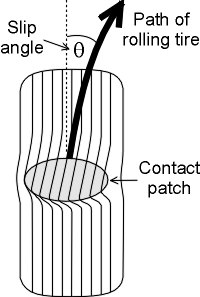I think what is perceieved as crisp steering response on RFTs is primarily due to the reduced slip angle because of the lack of compliance of the side wall. Lack of slip angle and reduced side wall compliance is not necessarily a good thing.
I found a number of issues with the RFTs in addition to the jarring ride. They do not keep the contact patch on the road over rough surfaces and this can cause the rear end to step out on a bumpy curve. They also tend to not give as much warning as non RFTs when they are about to loose grip. In the hands of a driver who is not used to driving at the cars limits (i.e. almost everyone) this can be treacherous.
=====================
Slip Angle
A tire can only sustain a certain amount of force(s) until it loses traction; it starts to slip (Hence the term slip angle). And when it starts to slip speed is lost.
Slip angle is a term that tells you how much a tire is skidding (sliding/slipping). A bigger slip angle (measured in degrees of course) means that the tire starts to slide more...
Letís define what slip angle is:
When a tire is cornering the contact patch has to resist the forces of friction between the rubber and the road surface. Due to the elastic nature of the tire the tread is distorted in the way that forces are working at that particular time. Itís resisting the turning action, thus pointing a different way than the actual desired path.
This angular difference is called slip angle.
When a car enters a corner, all the tyres are turned with respect to the ground. Due to the elasticity of the pneumatic tyre, the tread in the contact patch will resist the turning action because there is friction generated between the rubber and the road surface. As a result, the treads on the contact patch will be distorted, whose direction always lags behind the direction of the wheel ( See figure in below ). We call the angular difference between the treads and the wheel's direction as Slip Angle.
 Note : the car is turning left
Tires seem to operate at their peak performance when they are under a few degrees of slip angle, they generate the most grip at that particular slip angle. For race and high performance tires this optimum slip angle is around 6 to 10 degrees while this number is a little lower for street tires.
Due to low traction surfaces rally drivers reach even bigger angles. In drifting you probably see the biggest slip angle of all motorsports, sometimes as high as 40 degrees!
If you are cornering and the slip angle is below its optimum range the tire is considered to be under-used. If itís above this range the tire is being over-used. The trick is to stay within this optimum range so you use the tires to their fullest potential
I
Note : the car is turning left
Tires seem to operate at their peak performance when they are under a few degrees of slip angle, they generate the most grip at that particular slip angle. For race and high performance tires this optimum slip angle is around 6 to 10 degrees while this number is a little lower for street tires.
Due to low traction surfaces rally drivers reach even bigger angles. In drifting you probably see the biggest slip angle of all motorsports, sometimes as high as 40 degrees!
If you are cornering and the slip angle is below its optimum range the tire is considered to be under-used. If itís above this range the tire is being over-used. The trick is to stay within this optimum range so you use the tires to their fullest potential
I